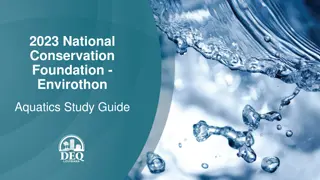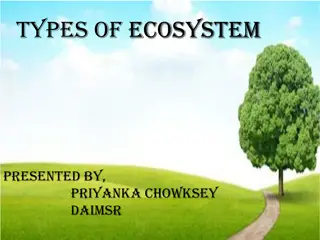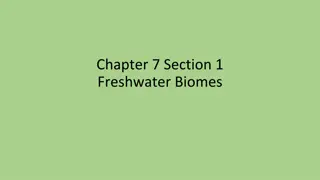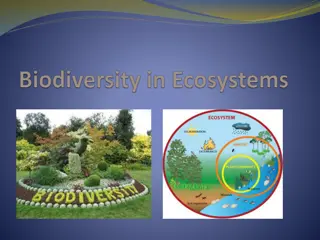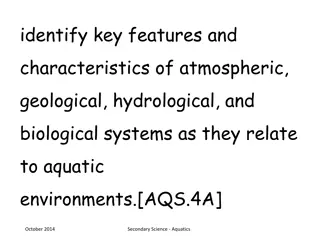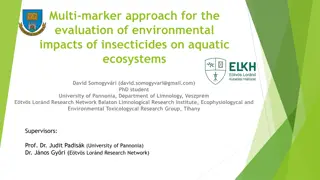Ecosystems: Types, Components, and Interactions
Different types of ecosystems, their components, and how they interact with each other. Explore natural ecosystems, such as deserts and rainforests, as well as artificial ecosystems. Discover the importance of terrestrial, aquatic, forest, marine, freshwater, tundra, and grassland ecosystems.
4 views • 6 slides
Dissolved Oxygen Measurements and Factors Affecting Oxygen Levels
Understanding the importance of dissolved oxygen in water is crucial for the survival of aquatic plants and animals. Factors such as chemical reactions, temperature, pressure, and light penetration influence oxygen levels. The Winkler method is commonly used for dissolved oxygen measurements. This m
6 views • 11 slides
2023 National Conservation Foundation - Envirothon
Explore the intricate dynamics of aquatic ecosystems and wetlands conservation through this comprehensive study guide. Discover the importance of watersheds, the hydrologic cycle, aquatic food webs, energy flow at trophic levels, and common macroinvertebrates in Louisiana. Learn about different wetl
3 views • 27 slides
Fish Ecology: Interactions, Diversity, and Environmental Factors
Fish ecology involves studying the distribution, interactions, and abundance of fish species in different ecosystems. This lab delves into the divisions of ecology, fish species diversity in marine and freshwater ecosystems, and the environmental factors affecting fish diversity and abundance. Disco
1 views • 7 slides
Adaptations of Aquatic Specimens, with a Focus on Sea Snakes
Aquatic specimens, particularly sea snakes of the subfamily Hydrophiinae, exhibit fascinating adaptations for their fully aquatic lifestyle. These marine snakes are uniquely adapted for life in the sea, with specialized features such as paddle-like tails, compressed bodies, and the ability to respir
0 views • 16 slides
Major Types of Ecosystems
Explore the diverse world of ecosystems, including grassland, aquatic, forest, and desert ecosystems. Learn about the biotic and abiotic factors that shape these environments and the critical roles they play in supporting life. Delve into forest ecosystems with their canopy, floor, and soil features
1 views • 29 slides
Freshwater Ecosystems: Lakes, Ponds, and More
Freshwater ecosystems offer a diverse range of habitats, from lakes and ponds to wetlands and rivers. These ecosystems host a variety of organisms adapted to different zones based on factors like sunlight and nutrients. Plankton, nekton, and benthos are key aquatic groups, with unique roles in the e
1 views • 24 slides
Importance of Biodiversity and Sustainability in Ecosystems
Biodiversity, the richness of life in genes, species, and ecosystems, plays a crucial role in sustaining the health of our planet and its inhabitants. It provides essential resources such as food, medicine, and economic benefits. Sustainability, the ability of ecosystems to maintain their structure
1 views • 6 slides
Plastic Pollution and Water Quality Impacts
Plastic pollution from manufacturing facilities and improper disposal practices has detrimental effects on water quality and aquatic life. Plastics not only harm aquatic species but also disrupt habitats and ecosystems. Initiatives such as plastic prohibition and best management practices are essent
0 views • 10 slides
Aquatic Adaptation in Animals
Aquatic adaptation refers to the changes in an animal's body organization to thrive in a water habitat. Vertebrates have evolved to lead partial or total aquatic lives, showcasing various adaptations. Water as a habitat offers a homogenous medium, stable conditions, and rich food resources. Aquatic
1 views • 9 slides
Environmental Factors in Terrestrial and Aquatic Environments
Environmental factors play a crucial role in shaping ecosystems. In both terrestrial (land) and aquatic (water) environments, organisms are influenced by abiotic factors such as temperature, light intensity, and pH, as well as biotic factors like plants, predators, and competitors. Understanding the
5 views • 19 slides
Aquatic Pollution and Its Impact on Water Quality
Aquatic pollution is a significant concern affecting the environment and human health. It includes various pollutants entering water bodies from land-based activities, causing harm to aquatic life and humans. Pollution sources can be classified into point source and non-point source. Monitoring wate
2 views • 13 slides
Ecosystems: Structure, Function, and Importance
Ecosystems are diverse and interconnected environments that consist of living and non-living components. This content explores the concept of ecosystems, their structure, functions, and the importance of understanding and preserving them. Topics covered include producers, consumers, decomposers, ene
0 views • 22 slides
Different Types of Ecosystems and Their Characteristics
Ecosystems are diverse environments encompassing both living organisms and non-living factors. From forest and grassland ecosystems to deserts and tundras, each type has unique features and interactions. Forests house a variety of organisms, while grasslands are dominated by grass and herbs. Deserts
0 views • 10 slides
Ecology: Ecosystems, Biodiversity, and Energy Flow
Explore the intricate world of ecology through topics such as ecosystems, biodiversity, energy flow, and nutrient cycling. Delve into the concept of niches, biodiversity levels, and the importance of energy flow and materials cycling in sustaining ecosystems. Learn about the nitrogen and carbon cycl
1 views • 18 slides
Aquatic Treatment Systems for Wastewater Reclamation and Reuse
In aquatic systems, wastewater treatment involves bacterial metabolism and sedimentation, with aquatic plants playing a role in improving treatment capabilities. This article discusses the functions of aquatic plants in treatment systems and the categories of wetlands used for wastewater treatment,
1 views • 15 slides
Ecosystems and Global Biomes: A Comprehensive Study
Explore the fascinating world of ecosystems, producers, consumers, and the vital role of decomposers within these intricate systems. Delve into the impact of environmental changes like deforestation on ecosystems. Discover the geographical features and significance of hot deserts, tropical forests,
0 views • 26 slides
Diverse Ecosystems through Visuals
Dive into the world of ecosystems with stunning images showcasing biogeographical realms, regions, ecological succession, lichens, mosses, forest types like coniferous, evergreen, deciduous, and thorn forests, as well as mangroves. Discover grassland ecosystems, fauna, desert ecosystems, and various
0 views • 20 slides
Ecosystems: Definition, Structure, and Function
Ecosystems consist of living and non-living parts forming stable systems. They involve energy flow, nutrient cycling, and interactions between organisms and their environment. Ecosystems vary in abiotic and biotic conditions, with producers, consumers, and decomposers playing key roles. Changes in t
0 views • 13 slides
Enhancing Local Economic Ecosystems for Sustainable Growth
Strategically defining and categorizing key players in local economic ecosystems can lead to more informed decision-making by public services, optimizing resource utilization, and maximizing community assets for impactful results. Ecosystem champions should possess a diverse skill set, including kno
0 views • 7 slides
The Iron Cycle and Aquatic Microbiology
Iron plays a crucial role in terrestrial and marine ecosystems, cycling between living organisms and the geosphere. It is a vital nutrient for plants, essential for chlorophyll production, and for animals, needed to create hemoglobin. The marine iron cycle involves phytoplankton and cyanobacteria as
0 views • 19 slides
Global Ecosystems and Climate Influences
Global ecosystems are defined by dominant vegetation types and are influenced by factors like climate, atmospheric circulation, altitude, relief, and ocean currents. The distribution and characteristics of ecosystems are shaped by global atmospheric circulation patterns, creating distinct belts of v
0 views • 18 slides
Immunotoxicity in Fish: An Alternative Model for Toxicological Studies
The study explores the immunotoxic effects of industrial effluents on fin fish, highlighting xenobiotics' impact on the immune system. It discusses the sensitivity of the immune system to environmental toxins and the elicitation of immune reactions by various substances. The importance of fish as a
0 views • 25 slides
Thermal Pollution and Its Sources
Thermal pollution is the detrimental effect of heated effluents discharged by power plants on aquatic and terrestrial ecosystems. This pollution occurs when the temperature of water bodies rises significantly due to human activities, leading to a reduction in dissolved oxygen and impacting aquatic l
0 views • 19 slides
Zooplankton Dynamics in Aquatic Ecosystems
Zooplankton play a crucial role in aquatic ecosystems by regulating algal populations, serving as a food source for fish, and maintaining ecological balance. This overview covers sampling methods, taxonomic classifications, density measurements, and the impact of zooplankton on fish populations. Iss
0 views • 18 slides
Identification of Aquatic Plants in Freshwater Bodies Based on Habitat Classification
Before identifying aquatic plants in freshwater bodies, it's vital to classify them into floating macrophytes, marginal macrophytes, submerged macrophytes, and emergent macrophytes. This classification aids in distinguishing various plant species such as Eichhornia, Salvinia, Pistia, Lemna, and Azol
0 views • 9 slides
Conservation Plan for Aquatic Habitat Restoration in New Braunfels
This plan outlines various projects aimed at managing aquatic habitats in New Braunfels for the restoration and preservation of native species such as the fountain darter. It includes objectives like flow manipulation, non-native vegetation control, and restoration of aquatic vegetation in the Comal
0 views • 17 slides
Aquatic Therapy: Benefits, Techniques, and Research Findings
Aquatic therapy, presented by Beverly Knight, SPT, offers a unique approach to rehabilitation with properties of water like buoyancy and resistance. This therapy can benefit patients with various conditions such as chronic pain, arthritis, and neurological impairments. The content covers indications
0 views • 22 slides
Sedimentation as Nonpoint Source Pollution in Aquatic Ecosystems
Explore the impact of sedimentation as a nonpoint source of pollution on aquatic ecosystems. Learn how sediment affects plant growth, disrupts the food web, and hinders the energy flow within the ecosystem. Discover why sedimentation is detrimental to life and why it is crucial to address this form
0 views • 22 slides
Marine Aquaculture Impacts on Submersed Aquatic Vegetation
The document explores the impacts of structures and shading used in commercial shellfish mariculture activities on submersed aquatic vegetation, particularly seagrasses. It discusses the varying effects of mariculture structures on eelgrass density, productivity, and the potential habitat they provi
0 views • 11 slides
Food Webs in Aquatic Habitats
Exploring the intricate relationships within aquatic food webs, this content delves into the control of beneficial and pest species, highlighting the importance of biodiversity and the factors that influence species presence and success. From the role of frogs in the ecosystem to the impact on tadpo
1 views • 6 slides
Biotic Communities and Benthic Ecosystems
Living organisms in an area form biotic communities categorized into producers, consumers, omnivores, detrivores, and decomposers. Aquatic organisms such as plankton, benthos, and nekton play vital roles. Benthic communities refer to organisms attached to or burrowing in aquatic ecosystems, influenc
0 views • 17 slides
Aquatic Environments: Systems and Interactions
Explore the key features and characteristics of atmospheric, geological, hydrological, and biological systems in relation to aquatic environments. Apply systems thinking to analyze positive and negative feedback cycles. Utilize technology to collect and evaluate global environmental data. Evaluate d
0 views • 28 slides
Aquatic Resources and Climate Concerns in Guam
Guam boasts diverse aquatic resources including coral reefs, shorelines, wetlands, and rivers, supporting a wide range of marine and freshwater organisms. However, these resources face threats from climate change effects such as rising sea levels, ocean acidification, and coral bleaching. The increa
0 views • 14 slides
Aquatic Microbial Groups and Their Environments
Explore the diverse world of aquatic microbial groups, their distribution in different water bodies, and their roles in ecosystems. Learn about the factors influencing microbial growth in water, the impact of eutrophication, bioremediation strategies, and the unique microbial communities found in es
0 views • 18 slides
Multi-Marker Approach for Evaluating Environmental Impacts of Neonicotinoids on Aquatic Ecosystems
Neonicotinoids, a class of insecticides, are widely used in agriculture but pose environmental risks to aquatic organisms. This study by David Somogyvári explores the effects of neonicotinoids on aquatic ecosystems using a multi-marker approach, focusing on the toxicity levels and potential impacts
0 views • 18 slides
Aquatic Adaptations in Marine Life
This informative content discusses the primary and secondary aquatic adaptations in marine animals such as fish, whales, turtles, and ducks. It covers various adaptations like streamlined bodies, presence of swim bladders, flippers for navigation, and webbed feet for swimming. Each adaptation is vit
1 views • 14 slides
Heavy Metal Toxicity: Impacts on Aquatic Life and Human Health
Heavy metal toxicity poses a significant threat to both aquatic ecosystems and human health, with various heavy metals accumulating in the environment and food chain. This overview highlights the adverse effects of heavy metals like copper, nickel, zinc, cobalt, and cadmium on physiological processe
0 views • 39 slides
Aquatic Facility Regulation and Guidance Reviews
This content covers regulations, reviews, and consultations related to aquatic facilities in Victoria, focusing on public health and wellbeing legislation. It includes information on maintaining aquatic facilities, water quality requirements, policy analysis, and consultation feedback to address pat
0 views • 11 slides
Diverse Aquatic Microorganisms
The images showcase various microscopic organisms found in freshwater and marine environments, including cyanobacteria, diatoms, green algae, and dinoflagellates. Each organism plays a crucial role in aquatic ecosystems and contributes to the overall biodiversity of water bodies.
0 views • 14 slides


